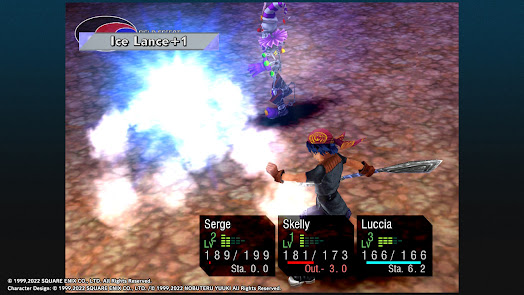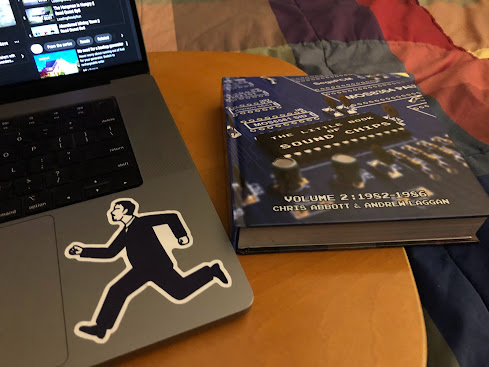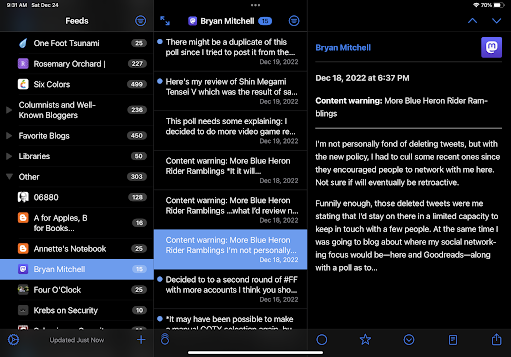 |
| A Polygonal Finisher—or "Classic" mode in its full glory. (Captured in Handheld Mode) |
Nintendo Force ran a Player’s Poll survey in their forty-eighth issue asking readers about their favorite third-party titles and companies. I decided to write in—having almost nine months time with the Switch—saying that the company I loved the most at that moment was Square Enix for putting their back catalog of late 90’s (and early 2000s) Final Fantasy titles onto the Switch. When I first got the Switch and jumped onto the eShop, one of the first titles I bought from that set was Final Fantasy VIII after recalling Kim Justice’s in-depth review and narrative analysis of the game. Then a couple weeks later, I decided that I also wanted to see what all the fuss was about with Final Fantasy VII and Louis Rossmann’s YouTube AMAs (ask me anything) are to blame for my purchase of Final Fantasy IX when it went on sale. I have yet to finish any one of these, but to be able to experience some of the best Japanese role-playing games that I could only experience previously via YouTube walkthroughs is an incredible thing.
That Nintendo Direct announcement of Chrono Cross: The Radical Dreamers in February took me by surprise. My only exposure to its prequel, Chrono Trigger, was with the port on the Nintendo DS shortly before I graduated high school in 2009. I remember, more than anything else, turning it on just to listen to the soundtrack, but the game itself pulled no punches. It was a time travel story, but it managed to keep things simple with a memorable cast of characters, a tired and true battle system, and a small world map which made every place matter—even the optional ones.
Chrono Cross ideally would follow a good opening act with a grand show, right?
 |
| Minimalism is Radical Dreamers's greatest strength. (Captured in Handheld Mode) |
Before we answer that question, let’s tackle the other game in the Radical Dreamers Edition—the collection’s tagline namesake. Radical Dreamers: Le Trésor Interdit—which translates from French as “the Forbidden Treasure”—was an obscure visual novel that required a Super Famicom and Satellaview peripheral so you could download it via a series of well…satellites—occupying a strange space between Sega’s Mega Modem and high-speed broadband. Visual novel may be a bit of an overstatement here as most of the screens look more like a text adventure game or MS-DOS, but the blackness in and of itself makes up for it.
Radical Dreamers puts you in the shoes of a Serge, a musician who finds himself teaming up with a thief named Kid and her partner, Magil, in order to infiltrate Viper Manor and nick a jewel called the “Frozen Flame”. The game is not shy in letting you know that you are back in the world of Chrono Trigger as many players who played that game, or are familiar with the story, will already make a connection in the opening scene where the trio mucks around the manor’s perimeter. Upon entering the manor, the screen goes black, you go down one end of a corridor, a somber track plays while Serge narrates their journey, and a Griffin screams at you with its claws ready to tear you apart.
That last part is one in a possible series of random encounters you will experience in sneaking around the mansion. Sometimes, it’s a skeleton who is usually easy to deal with, a goblin that takes pride in its combat training, a ghost who whooshes in with the wind…or its the griffin. The creature’s 16-bit shrill, which comes out of nowhere, always made me jump, but many of these encounters do require you to be alert and ready to choose your next move. If you do nothing, the monster might come out on top and force you to go through the entire game again. If you know the right path in the manor, it is only a minor inconvenience, but your first few heist attempts may be slightly frustrating.
Thing is, these encounters add to the already foreboding atmosphere of Viper Manor. There’s barely any music in the game and the track which plays while you sneak around makes the place more like something out of a horror movie. Most of the rooms, which do have proper backdrops, are dimly lit. If the griffin was not scary enough, the development team made excellent use of the Super Famicom’s sound chip to make the manor seem haunted for its strange emptiness and odd architecture.
For a game you could easily complete in an hour’s sitting, Radical Dreamers does a bang up job of making the trek worth it. This was easily my highlight of the collection, both as someone who played Chrono Trigger and a fan of little gaming oddities, and I might go through this again one day to see the multiple endings for myself.
 |
| In Which a Fisherman Deals a Possibly Fatal Blow to a DRAGOON (Captured in Handheld Mode) |
Chrono Cross, however, is a different matter which started out as a promising trip in one of Nostalgia’s newly constructed side streets. You start out as Serge, but instead of treading around a well-guarded mansion in the cover of night, you find yourself ascending an ancient, ornate building. Kid is still with you and your mission this time is just to take down a character called Lynx—who was also Viper Mansion’s owner in Radical Dreamers—with some other person who is one out of a myriad number of party members you can recruit. Upon entering the chamber that sits way above the building itself, Serge witnesses himself, blood dripping from his dagger with a sly grin on his face as the screen flashes to Kid lying on the ground, dead. It gets stranger from there as this whole sequence was merely a dream and the Serge of Chrono Cross has no idea who Kid is.
The game’s opening moments do a genuinely decent job at introducing the story and core gameplay mechanics, but the battle system feels very unwieldy. Instead of the Active Time Battle system used in Chrono Trigger—where using Techs was as easy as casting a simple spell—Chrono Cross makes an attempt at making its fights stand out from similar games. Attacks take a certain amount of stamina, meaning that you can put a good amount of oomph into a strong strike, or chain a flurry of weaker attacks to keep your party from completely wearing down. These attacks also help to fill up an “element” grid for each character so they can cast a particular set of spells—you will want to keep fighting so you can belt out your strongest hexes. Trouble is, if you bypass the village chief at the game’s onset, this whole system will not make any sense whatsoever. The inclusion of field effects and summons complicate things a bit further—I hardly used any of the latter in my play through—and winning battles feels more like doing so in one of the SaGa games (Romancing Saga 1-3 and SaGa Frontier) where instead of experience, you get varying stat boots. Defeating a boss does net you a star—which you can use for summon elementals—and a few extra spaces on your party’s elemental grid, but it hardly feels like your getting stronger.
It gets more complicated from there as your team does not learn “element” spells—aside from at least three unique attacks per person—but you either find them scattered about throughout the world, or you can buy them off particular vendors. Some of them are exclusive to party members whose “innate element” aligns with the color of a particular spell, but thankfully those ones only come up in the late game. Allocating specific spells could either be a simple matter or a micromanager’s worst nightmare since there are options to automatically add or remove elements and that leads us to the biggest wrench in the works: your team.
 |
| One of the More Eccentric Recruits on your Journey Through Sea and Space (Captured in Handheld Mode) |
There are so many characters that you can choose to recruit…or decide to join you because they have nothing better to do, which seems like a good selling point. The execution leaves much to be desired…and that is putting it lightly. In one word, it is overwhelming. The thing with the elements is just the start of it since all of them have their own weapons and armor that you have to gather materials in order for the blacksmith to forge them. The easy thing to say, and my best advice, would have been to concentrate on Serge and your two other favorite teammates—or the ones who would oppose a particular boss’s innate element—but near the end of the proverbial “part one”, you are forced to build a new squad after a dramatic event. In another word, or rather two, it is a mess.
There is a reason why I started this review by looking at Radical Dreamers first and it is not because of the fact that Chrono Cross is a bad game. The soundtrack is beautiful, the locales are stunning in concept (more on the graphics later), and it’s partially an adaptation of the Satellaview game. Kid plays as much of a pivotal role in Chrono Cross as she did in Radical Dreamers, at least in theory anyway. The game has its own version of the Viper Manor with an updated rendition of the “Snakebone Mansion” track to go with it. Even the key heist remains the same, mostly. After that sequence concludes followed by another fetch quest, Kid can easily be forgotten with Serge being the party member you can not change out. Even with barely a legion at your disposal, you could put the pivotal thief on the backbench in favor of a popular rockstar, a lab technician, a priestly Luchador, or even a literal voodoo doll (and the bizarreness does not end there). The majority of them barely make any dents in the story outside of about thirty-five percent of the cast—if you decide to play the game in full, it is easy to figure out who the big narrative players are.
The saving grace of this remaster is the little tools that, with a press of a button, you can become invincible to even the most powerful foes, avoid random encounters altogether, or just breeze through the entire game on fast-forward. However, they just make the flaws in the story more apparent with the huge absence of Kid between two narrative strands and in that void is where my interest in the game dropped. Or rather, I took the tinted-glasses off upon realizing that this was not the harbor I thought it was with tools that were less like brandishing a Swiss Army Knife and more like trying to fix a modern-day laptop.
 |
| An attempt at showcasing the "New" graphical mode. Notice the details on his clothing. (Captured in Handheld Mode) |
The last niggle about the entire collection is the assortment of display settings—which are almost solely a
Chrono Cross affair. I have no right to comment on the comparisons between the remaster and the original Playstation game seeing as my only experience of the game was a bunch of YouTube walkthrough videos. The different display and graphic modes leave much to be desired though with “full” being way too stretched out all all ends and “zoomed” being slightly longer on the big screen along with readable onscreen text. The 4:3 option was the one I stuck with throughout my playthrough which was perfect on portable along with the “classic” graphical style, which feels like a CRT filter, but merely pixelates the text and keeps the original artwork and character models, “New” seems like the binary opposite with good intentions—the backgrounds feel more like a series of murals, the text is made clean and spotless, and everyone gets an updated model…which weirdly introduces tremendous slowdown. I had the luck of testing out the “New” graphics at the worst possible moment in which a tank, built and driven by dwarves, drives onto the battlefield and brings the game to a sluggish pace—it is worse when it attacks the party.
On its own, Radical Dreamers would earn an easy nine out of ten from me. With it being bundled with Chrono Cross at a twenty dollar price point it is an entirely different story. Those who loved Chrono Trigger to bits might want to give this a go to see how everything plays out and if the references make any sense. Otherwise, I would sail far away from this maelstrom.
In Sum: A collection with an odd gem and a sequel to a well-loved game that distances itself from it in almost every aspect aside from name-dropping and musical lemotifs. A presumed classic which wants to be a more detailed adaptation of said gem, but gets lost due to the staggering number of party members who unintentionally stomp all over the story that was. A treasure chest of interesting ideas that, in execution, do not exactly sparkle or earn the appraiser's full attention.
A piece of history stuck in time and floating aimlessly in space.
Score: 6.0 out of 10
Additional Notes: Some of the answer's from the Player's Poll were published in Nintendo Force's following issue.










































